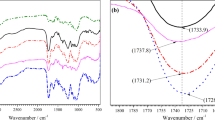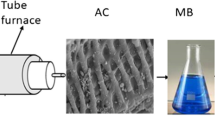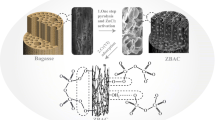Abstract
Sugarcane bagasse activated carbon (SBAC) was used as an environmentally friendly adsorbent for the removal of zinc (II) heavy metal from aqueous solutions at neutral pH. Zinc (II) adsorption efficiency was evaluated at different process parameters including adsorbent dosage, contact time, and temperature using general factorial as an experimental design to evaluate the maximum adsorption efficiency. The synthesized SBAC was subjected to advanced characterization techniques that include FTIR, XRD, and TGA/DTA to study the functional groups, crystallinity, and thermal property, respectively. Chemically modified SBAC was able to reduce initial metal concentrations by 82.4%. The optimized process parameters that give maximum removal efficiency were obtained at 40 min, 6 gm, and 60 °C. The experimental data were fitted to Langmuir, Freundlich, and Temkin models. Pseudo-first-order, pseudo-second-order, and intraparticle diffusion models were used to model adsorption kinetics. The experimental data were best fitted to the pseudo-second-order kinetic model with Langmuir isotherm. An important parameter from the isotherm which indicates adsorption capacity was 426.64 mg/g. The thermodynamic parameters for entropy, ΔS, enthalpy, ΔH, and the Gibbs free energy, ΔG, reveal that the adsorption of zinc (II) by the SBAC is endothermic, thermodynamically feasible, and a spontaneous process.
Graphical abstract







Similar content being viewed by others
Data Availability
All data generated or analyzed during this study are included in this published article.
References
Ahmad, F., Daud, W. M. A. W., Ahmad, M. A., & Radzi, R. (2013). The effects of acid leaching on porosity and surface functional groups of cocoa (Theobroma cacao)-shell based activated carbon. Chemical Engineering Research and Design, 91(6), 1028–1038. https://doi.org/10.1016/j.cherd.2013.01.003
Ajjabi, L. C., & Chouba, L. (2009). Biosorption of Cu2+ and Zn2+ from aqueous solutions by dried marine green macroalga Chaetomorpha linum. Journal of Environmental Management, 90(11), 3485–3489. https://doi.org/10.1016/j.jenvman.2009.06.001
Ali, I., & Gupta, V. K. (2007). Advances in water treatment by adsorption technology. Nature Protocols, 1(6), 2661–2667. https://doi.org/10.1038/nprot.2006.370
Anoop Krishnan, K., & Anirudhan, T. S. (2002). Removal of mercury(II) from aqueous solutions and chlor-alkali industry effluent by steam activated and sulphurised activated carbons prepared from bagasse pith: Kinetics and equilibrium studies. Journal of Hazardous Materials, 92(2), 161–183. https://doi.org/10.1016/S0304-3894(02)00014-6
Armbruster, M. H., & Austin, J. B. (1938). The adsorption of gases on plane surfaces of mica. Journal of the American Chemical Society, 60(2), 467–475. https://doi.org/10.1021/ja01269a066
Aslam, M. M., Hassan, I., & Malik, M. (2004). Sand as adsorbent for removal of zinc from industrial effluents. Electron. J. Environ. Agric. Food Chem, 3(6), 792-798.
ASTM E872-82. (2013). Standard test method for volatile matter in the analysis of particulate wood fuels. Annual Book of ASTM Standard, American Society for Testing and Materials.
Bello, O. S., Adegoke, K. A., & Akinyunni, O. O. (2017). Preparation and characterization of a novel adsorbent from Moringa oleifera leaf. Applied Water Science, 7(3), 1295–1305. https://doi.org/10.1007/s13201-015-0345-4
Bhattacharya, A. K., Mandal, S. N., & Das, S. K. (2006). Adsorption of Zn(II) from aqueous solution by using different adsorbents. Chemical Engineering Journal, 123(1–2), 43–51. https://doi.org/10.1016/j.cej.2006.06.012
Capeletti, L. B., & Zimnoch, J. H. (2016). Fourier transform infrared and Raman characterization of silica-based materials. Applications of molecular spectroscopy to current research in the chemical and biological sciences, 1–21. https://doi.org/10.5772/64477
Channiwala, S. A., & Parikh, P. P. (2002). A unified correlation for estimating HHV of solid, liquid and gaseous fuels. Fuel, 81(8), 1051–1063. https://doi.org/10.1016/S0016-2361(01)00131-4
Demirbas, A. (2008). Heavy metal adsorption onto agro-based waste materials: A review. Journal of Hazardous Materials, 157(2–3), 220–229. https://doi.org/10.1016/j.jhazmat.2008.01.024
Dlapa, P., Bodí, M. B., Mataix-Solera, J., Cerdà, A., & Doerr, S. H. (2013). FT-IR spectroscopy reveals that ash water repellency is highly dependent on ash chemical composition. CATENA, 108, 35–43. https://doi.org/10.1016/j.catena.2012.02.011
Freundlich, H. M. F. (1906). Over the adsorption in solution. Journal of Physical Chemistry, 57(385471), 1100–1107.
Garca-Pèrez, M., Chaala, A., & Roy, C. (2002). Vacuum pyrolysis of sugarcane bagasse. Journal of Analytical and Applied Pyrolysis, 65(2), 111–136. https://doi.org/10.1016/S0165-2370(01)00184-X
Govindarajan, D., & Jayalakshmi, G. (2011). XRD, FTIR, and SEM studies on calcined sugarcane bagasse ash blended cement. Archives of Physics Research, 2(4), 38–44. Retrieved on June 12, 2022 from https://scholarsresearchlibrary.com/archive.html
Guan, B. T. H., Latif, P. A., & Yap, T. Y. H. (2013). Physical preparation of activated carbon from sugarcane bagasse and corn husk and its physical and chemical characteristics. International Journal of Engineering Research and Science & Technology, 2(3), 1–14.
Gupta, V. K., & Ali, I. (2000). Utilisation of bagasse fly ash (a sugar industry waste) for the removal of copper and zinc from wastewater. Separation and Purification Technology, 18(2), 131–140. https://doi.org/10.1016/S1383-5866(99)00058-1
Gupta, V. K., & Ali, I. (2004). Removal of lead and chromium from wastewater using bagasse fly ash - A sugar industry waste. Journal of Colloid and Interface Science, 271(2), 321–328. https://doi.org/10.1016/j.jcis.2003.11.007
Hassan, M. L., & El-Wakil, N. A. (2003). Heavy metal ion removal by amidoximated bagasse. Journal of Applied Polymer Science, 87(4), 666–670. https://doi.org/10.1002/app.11402
Ho, Y. S. (2003). Removal of copper ions from aqueous solution by tree fern. Water Research, 37(10), 2323–2330. https://doi.org/10.1016/S0043-1354(03)00002-2
Ho, Y. S., & Mckay, G. (1999). Pseudo-second order model for sorption processes. 34, 451–465.
Horsfall, M., & Abia, A. A. (2003). Sorption of cadmium(II) and zinc(II) ions from aqueous solutions by cassava waste biomass (Manihot sculenta Cranz). Water Research, 37(20), 4913–4923. https://doi.org/10.1016/j.watres.2003.08.020
Hu, Y., Dong, X., Nan, J., Jin, W., Ren, X., Xu, N., & Lee, Y. M. (2011). Metal-organic framework membranes fabricated via reactive seeding. Chemical Communications, 47(2), 737–739. https://doi.org/10.1039/c0cc03927f
Jaafarzadeh, N., Mengelizadeh, N., Takdastan, A., Heidari-Farsani, M., & Niknam, N. (2014). Adsorption of Zn (II) from aqueous solution by using chitin extraction from crustaceous shell. Journal of Advances in Environmental Health Research, 2(2), 110–119.
Jagaba, A. H., Kutty, S. R. M., Khaw, S. G., Lai, C. L., Isa, M. H., Baloo, L., Lawal, I. M., Abubakar, S., Umaru, I., & Zango, Z. U. (2020). Derived hybrid biosorbent for zinc(II) removal from aqueous solution by continuous-flow activated sludge system. Journal of Water Process Engineering, 34(November 2019), 101152. https://doi.org/10.1016/j.jwpe.2020.101152
Jawad, A. H., Sabar, S., Ishak, M. A. M., Wilson, L. D., Ahmad Norrahma, S. S., Talari, M. K., & Farhan, A. M. (2017). Microwave-assisted preparation of mesoporous-activated carbon from coconut (Cocos nucifera) leaf by H3PO4 activation for methylene blue adsorption. Chemical Engineering Communications, 204(10), 1143–1156. https://doi.org/10.1080/00986445.2017.1347565
Jawad, A. H., Razuan, R., Appaturi, J. N., & Wilson, L. D. (2019). Adsorption and mechanism study for methylene blue dye removal with carbonized watermelon (Citrullus lanatus)rind prepared via one-step liquid phase H 2 SO 4 activation. Surfaces and Interfaces, 16(April), 76–84. https://doi.org/10.1016/j.surfin.2019.04.012
Jembere, A. L., & Genet, M. B. (2021). Comparative adsorptive performance of adsorbents developed from sugar industrial wastes for the removal of melanoidin pigment from molasses distillery spent wash. Water Resources and Industry, 26, 100165. https://doi.org/10.1016/j.wri.2021.100165
Kadirvelu, K., Thamaraiselvi, K., & Namasivayam, C. (2001). Removal of heavy metals from industrial wastewaters by adsorption onto activated carbon prepared from an agricultural solid waste. Bioresource Technology, 76(1), 63–65. https://doi.org/10.1016/S0960-8524(00)00072-9
Karnitz, O., Gurgel, L. V. A., de Melo, J. C. P., Botaro, V. R., Melo, T. M. S., de Freitas Gil, R. P., & Gil, L. F. (2007). Adsorption of heavy metal ion from aqueous single metal solution by chemically modified sugarcane bagasse. Bioresource Technology, 98(6), 1291–1297. https://doi.org/10.1016/j.biortech.2006.05.013
Katyal, S., Thambimuthu, K., & Valix, M. (2003). Carbonisation of bagasse in a fixed bed reactor: Influence of process variables on char yield and characteristics. Renewable Energy, 28(5), 713–725. https://doi.org/10.1016/S0960-1481(02)00112-X
Khalfaoui, A., & Meniai, A. H. (2012). Application of chemically modified orange peels for removal of copper(II) from aqueous solutions. Theoretical Foundations of Chemical Engineering, 46(6), 732–739. https://doi.org/10.1134/S0040579512060103
Kılıç, Z., Atakol, O., Aras, S., Cansaran-Duman, D., & Emregul, E. (2014). Biosorption properties of zinc(II) from aqueous solutions by pseudevernia furfuracea (L.) zopf. Journal of the Air and Waste Management Association, 64(10), 1112–1121. https://doi.org/10.1080/10962247.2014.926299
Kim, D. Y., Nishiyama, Y., Wada, M., & Kuga, S. (2001). High-yield carbonization of cellulose by sulfuric acid impregnation. Cellulose, 8(1), 29–33. https://doi.org/10.1023/A:1016621103245
Lu, J. J., & Chen, W. H. (2015). Investigation on the ignition and burnout temperatures of bamboo and sugarcane bagasse by thermogravimetric analysis. Applied Energy, 160(2015), 49–57. https://doi.org/10.1016/j.apenergy.2015.09.026
Lu, S., Gibb, S. W., & Cochrane, E. (2007). Effective removal of zinc ions from aqueous solutions using crab carapace biosorbent. Journal of Hazardous Materials, 149(1), 208–217. https://doi.org/10.1016/j.jhazmat.2007.03.070
Mahmoud, M. A. (2014). Adsorption of cadmium onto orange peels: Isotherms, kinetics, and thermodynamics. Journal of Chromatography & Separation Techniques, 05(05). https://doi.org/10.4172/2157-7064.1000238
Maia, L. S., Duizit, L. D., Pinhatio, F. R., & Mulinari, D. R. (2021). Valuation of banana peel waste for producing activated carbon via NaOH and pyrolysis for methylene blue removal. Carbon Letters, 31, 749–762.
Manju, G. N., Raji, C., & Anirudhan, T. S. (1998). Evaluation of coconut husk carbon for the removal of arsenic from water. Water Research, 32(10), 3062–3070. https://doi.org/10.1016/S0043-1354(98)00068-2
McKay, G., Ho, Y. S., & Ng, J. C. Y. (1999). Biosorption of copper from waste waters: A review. Separation and Purification Methods, 28(1), 87–125. https://doi.org/10.1080/03602549909351645
Mesa-Perez, J. M., Cortez, L. A. B., Rocha, J. D., Brossard-Perez, L. E., & Olivares-Gómez, E. (2005). Unidimensional heat transfer analysis of elephant grass and sugar cane bagasse slow pyrolysis in a fixed bed reactor. Fuel Processing Technology, 86(5), 565–575. https://doi.org/10.1016/j.fuproc.2004.05.014
Mohapatra, M., Khatun, S., & Anand, S. (2009). Kinetics and thermodynamics of lead (II) adsorption on lateritic nickel ores of Indian origin. Chemical Engineering Journal, 155(1–2), 184–190. https://doi.org/10.1016/j.cej.2009.07.035
Mopoung, S., Moonsri, P., Palas, W., & Khumpai, S. (2015). Characterization and properties of activated carbon prepared from tamarind seeds by KOH activation for Fe(III) adsorption from aqueous solution. Scientific World Journal https://doi.org/10.1155/2015/415961
Mulana, F., Mariana, M., Muslim, A., Mohibah, M., & Halim, K. H. K. (2018). Removal of zinc (II) ion from aqueous solution by adsorption onto activated palm midrib bio-sorbent. IOP Conference Series: Materials Science and Engineering, 334(1). https://doi.org/10.1088/1757-899X/334/1/012027
Mulinari, D. R., Voorwald, H. J. C., Cioffi, M. O. H., da Silva, M. L. C. P., & Luz, S. M. (2009). Preparation and properties of HDPE/sugarcane bagasse cellulose composites obtained for thermokinetic mixer. Carbohydrate Polymers, 75(2), 317–321. https://doi.org/10.1016/j.carbpol.2008.07.028
Nada, A. A. M. A., & Hassan, M. L. (2006). Ion exchange properties of carboxylated bagasse. Journal of Applied Polymer Science, 102(2), 1399–1404. https://doi.org/10.1002/app.24255
Van Nam, H., Tam, T. T., & Tho, V. D. S. (2019). Kinetic modeling of thermal decomposition of sugarcane bagasse in the inert gas environment. In Vietnam Journal of Chemistry 57(Issue 5) 574–580. https://doi.org/10.1002/vjch.201900077
Pereira, F. V., Gurgel, L. V. A., De Aquino, ŚF., & Gil, L. F. (2009). Removal of Zn2+ from electroplating wastewater using modified wood sawdust and sugarcane bagasse. Journal of Environmental Engineering, 135(5), 341–350. https://doi.org/10.1061/(ASCE)0733-9372(2009)135:5(341)
Pereira, F. V., Gurgel, L. V. A., & Gil, L. F. (2010). Removal of Zn2+ from aqueous single metal solutions and electroplating wastewater with wood sawdust and sugarcane bagasse modified with EDTA dianhydride (EDTAD). Journal of Hazardous Materials, 176(1–3), 856–863. https://doi.org/10.1016/j.jhazmat.2009.11.115
Petrov, N., Budinova, T., Razvigorova, M., Ekinci, E., Yardim, F., & Minkova, V. (2000). Preparation and characterization of carbon adsorbents from furfural. Carbon, 38(15), 2069–2075. https://doi.org/10.1016/S0008-6223(00)00063-4
Phuengphai, P., Singjanusong, T., Kheangkhun, N., & Wattanakornsiri, A. (2021). Removal of copper(II) from aqueous solution using chemically modified fruit peels as efficient low-cost biosorbents. Water Science and Engineering, 14(4), 286–294. https://doi.org/10.1016/j.wse.2021.08.003
Standard, A. S. T. M. (1755). 01 (2007) Standard test method for ash in biomass. American Society for Testing and Materials (ASTM) Philadelphia.
ASTM, E. 1756 (2015). Standard Test Method for Determination of Total solids in Biomass. ASTM International, West Conshohocken PA.
Qian, C., Li, Q., Zhang, Z., Wang, X., Hu, J., & Cao, W. (2020). Prediction of higher heating values of biochar from proximate and ultimate analysis. Fuel, 265, 1128–1132. https://doi.org/10.1016/j.fuel.2019.116925
Rajbhandari, R., Shrestha, L. K., Pokharel, B. P., & Pradhananga, R. R. (2013). Development of nanoporous structure in carbons by chemical activation with zinc chloride. Journal of Nanoscience and Nanotechnology, 13(4), 2613–2623. https://doi.org/10.1166/jnn.2013.7373
Rengaraj, S., Yeon, K. H., & Moon, S. H. (2001). Removal of chromium from water and wastewater by ion exchange resins. Journal of Hazardous Materials, 87(1–3), 273–287. https://doi.org/10.1016/S0304-3894(01)00291-6
Rozada, F., Otero, M., García, A. I., & Morán, A. (2007). Application in fixed-bed systems of adsorbents obtained from sewage sludge and discarded tyres. Dyes and Pigments, 72(1), 47–56. https://doi.org/10.1016/j.dyepig.2005.07.016
Runtti, H., Tuomikoski, S., Kangas, T., Kuokkanen, T., Rämö, J., & Lassi, U. (2016). Sulphate removal from water by carbon residue from biomass gasification: Effect of chemical modification methods on sulphate removal efficiency. BioResources, 11(2), 3136–3152. https://doi.org/10.15376/biores.11.2.3136-3152
Safari, E., Rahemi, N., Kahforoushan, D., & Allahyari, S. (2019). Copper adsorptive removal from aqueous solution by orange peel residue carbon nanoparticles synthesized by combustion method using response surface methodology. Journal of Environmental Chemical Engineering, 7, 102847. https://doi.org/10.1016/j.jece.2018.102847
Salihi, I. (2015). InCIEC 2014. InCIEC 2014, June 2017. https://doi.org/10.1007/978-981-287-290-6
Šćiban, M., Radetić, B., Kevrešan, Ž, & Klašnja, M. (2007). Adsorption of heavy metals from electroplating wastewater by wood sawdust. Bioresource Technology, 98(2), 402–409. https://doi.org/10.1016/j.biortech.2005.12.014
Senthilkumar, R., Vijayaraghavan, K., Thilakavathi, M., Iyer, P. V. R., & Velan, M. (2006). Seaweeds for the remediation of wastewaters contaminated with zinc(II) ions. Journal of Hazardous Materials, 136(3), 791–799. https://doi.org/10.1016/j.jhazmat.2006.01.014
Sia, G. B., Vernasqui, L. G., Consolin-Filho, N., Gonçalves, M. S., & Medeiros, F. V. da S. (2022). Zinc adsorption from aqueous solution on biosorbent from urban pruning waste. Environmental Technology (United Kingdom), 43(5), 728–736.https://doi.org/10.1080/09593330.2020.1803418
Sitko, R., Turek, E., Zawisza, B., Malicka, E., Talik, E., Heimann, J., Gagor, A., Feist, B., & Wrzalik, R. (2013). Adsorption of divalent metal ions from aqueous solutions using graphene oxide. Dalton Transactions, 42(16), 5682–5689. https://doi.org/10.1039/c3dt33097d
Srivastava, V. C., Mall, I. D., & Mishra, I. M. (2006). Equilibrium modelling of single and binary adsorption of cadmium and nickel onto bagasse fly ash. Chemical Engineering Journal, 117(1), 79–91. https://doi.org/10.1016/j.cej.2005.11.021
Tempkin, M. J., & Pyzhev, V. (1940). Recent modifications to Langmuir isotherms. Acta Physiochim. USSR, 12, 217–222.
Tsai, W. T., Lee, M. K., & Chang, Y. M. (2006). Fast pyrolysis of rice straw, sugarcane bagasse and coconut shell in an induction-heating reactor. Journal of Analytical and Applied Pyrolysis, 76(1–2), 230–237. https://doi.org/10.1016/j.jaap.2005.11.007
Wan Ngah, W. S., & Hanafiah, M. A. K. M. (2008). Removal of heavy metal ions from wastewater by chemically modified plant wastes as adsorbents: A review. Bioresource Technology, 99(10), 3935–3948. https://doi.org/10.1016/j.biortech.2007.06.011
Wang, F., Pan, Y., Cai, P., Guo, T., & Xiao, H. (2017). Single and binary adsorption of heavy metal ions from aqueous solutions using sugarcane cellulose-based adsorbent. Bioresource Technology, 241, 482–490. https://doi.org/10.1016/j.biortech.2017.05.162
Wuana, R. A., & Okieimen, F. E. (2011). Heavy Metals in Contaminated Soils: A Review of Sources, Chemistry, Risks and Best Available Strategies for Remediation. ISRN Ecology, 2011, 1–20. https://doi.org/10.5402/2011/402647
Yılmaz, O., & Tugrul, N. (2022). Zinc adsorption from aqueous solution using lemon, orange, watermelon, melon, pineapple, and banana rinds. Water Practice and Technology, 17(1), 318–328. https://doi.org/10.2166/wpt.2021.102
Zhan, W., Xu, C., Qian, G., Huang, G., Tang, X., & Lin, B. (2018). Adsorption of Cu(ii), Zn(ii), and Pb(ii) from aqueous single and binary metal solutions by regenerated cellulose and sodium alginate chemically modified with polyethyleneimine. RSC Advances, 8(33), 18723–18733. https://doi.org/10.1039/c8ra02055h
Zhang, X., Hao, Y., Wang, X., & Chen, Z. (2017). Rapid removal of zinc(II) from aqueous solutions using a mesoporous activated carbon prepared from agricultural waste. Materials, 10(9). https://doi.org/10.3390/ma10091002
Author information
Authors and Affiliations
Corresponding author
Ethics declarations
Conflict of Interest
The authors declare no competing interest.
Additional information
Publisher's Note
Springer Nature remains neutral with regard to jurisdictional claims in published maps and institutional affiliations.
Rights and permissions
About this article
Cite this article
Genet, M.B., Jembere, A.L. & Tafete, G.A. Economical Adsorbent Developed from Sugarcane Bagasse for Zinc (II) Removal from Wastewater. Water Air Soil Pollut 233, 295 (2022). https://doi.org/10.1007/s11270-022-05770-y
Received:
Accepted:
Published:
DOI: https://doi.org/10.1007/s11270-022-05770-y




